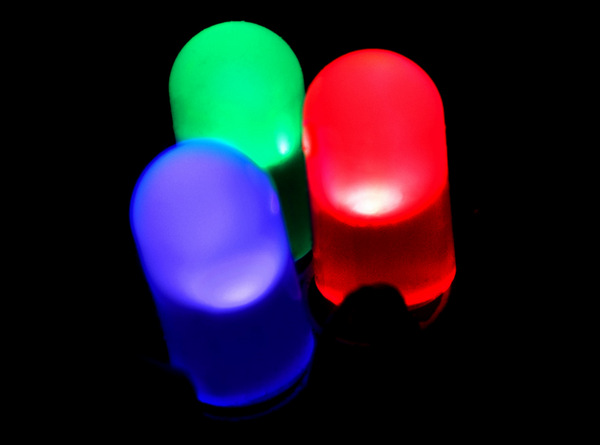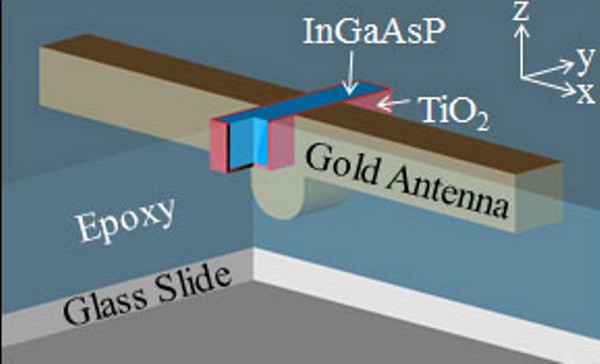 |
|
Spontaneous light emissions from LEDs can be substantially enhanced when coupled to the right optical antenna, making them comparable to the stimulated emissions from lasers. (Image from Wikipedia) |
Berkeley Lab researchers have developed a nano-sized optical antenna that can greatly enhance the spontaneous emission of light from atoms, molecules and semiconductor quantum dots. This advance opens the door to LEDs that can replace lasers for short-range optical communications, including optical interconnects for microchips, plus a host of other potential applications.
“Since the invention of the laser, spontaneous light emission has been looked down upon in favor of stimulated light emission,” says Eli Yablonovitch, an electrical engineer with Berkeley Lab’s Materials Sciences Division. “However, with the right optical antenna, spontaneous emissions can actually be faster than stimulated emissions.”
Yablonovitch, who also holds a faculty appointment with the University of California (UC) Berkeley where he directs the NSF Center for Energy Efficient Electronics Science (E3S), and is a member of the Kavli Energy NanoSciences Institute at Berkeley (Kavli ENSI), led a team that used an external antenna made from gold to effectively boost the spontaneous light emission of a nanorod made from Indium Gallium Arsenide Phosphide (InGaAsP) by 115 times. This is approaching the 200-fold increase that is considered the landmark in speed difference between stimulated and spontaneous emissions. When a 200-fold increase is reached, spontaneous emission rates will exceed those of stimulated emissions.
 |
|
Eli Yablonovitch is an award-winning electrical engineer with Berkeley Lab, UC Berkeley and Kavli ENSI (Photo Credit: Roy Kaltschmidt) |
“With optical antennas, we believe that spontaneous emission rate enhancements of better than 2,500 times are possible while still maintaining light emission efficiency greater than 50-percent,” Yablonovitch says. “Replacing wires on microchips with antenna -enhanced LEDs would allow for faster interconnectivity and greater computational power.”
The results of this study are reported in theProceedings of the National Academy of Sciences (PNAS) in a paper titled “Optical antenna enhanced spontaneous emission.” Yablonovitch and UC Berkeley’s Ming Wua are the corresponding authors. Co-authors are Michael Eggleston, Kevin Messer and Liming Zhang.
In the world of high technology lasers are ubiquitous, the reigning workhorse for high-speed optical communications. Lasers, however, have downsides for communications over short distances, i.e., one meter or less – they consume too much power and typically take up too much space. LEDs would be a much more efficient alternative but have been limited by their spontaneous emission rates.
“Spontaneous emission from molecular-sized radiators is slowed by many orders of magnitude because molecules are too small to act as their own antennas,” Yablonovitch says. “The key to speeding up these spontaneous emissions is to couple the radiating molecule to a half-wavelength antenna. Even though we’ve had antennas in radio for 120 years, somehow we’ve overlooked antennas in optics. Sometimes the great discoveries are looking right at us and waiting.”
 |
|
Coupling a gold antenna to a InGaAsP nanorod, isolated by TiO2 and embedded in epoxy, greatly enhanced the spontaneous light emission of the InGaAsP. (Photo Credit: Berkley Lab) |
For their optical antenna, Yablonovitch and his colleagues used an arch antenna configuration. The surface of a square-shaped InGaAsP nanorod was coated with a layer of titanium dioxide to provide isolation between the nanorod and a gold wire that was deposited perpendicularly over the nanorod to create the antenna. The InGaAsP semiconductor that served as the spontaneous light-emitting material is a material already in wide use for infrared laser communication and photo-detectors.
In addition to short distance communication applications, LEDs equipped with optical antennas could also find important use in photodetectors. Optical antennas could also be applied to imaging, bio-sensing and data storage applications.
This research was supported by E3S, the U.S. Air Force Office of Scientific Research, and the U.S. Department of Energy’s Office of Science.
Additional Information
For more about the research of Eli Yablonovitch go here
For more about E3S go here





 CN
TW
EN
CN
TW
EN








